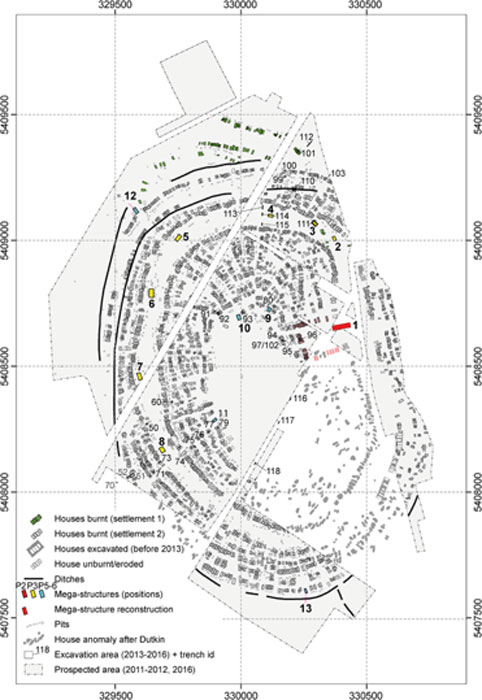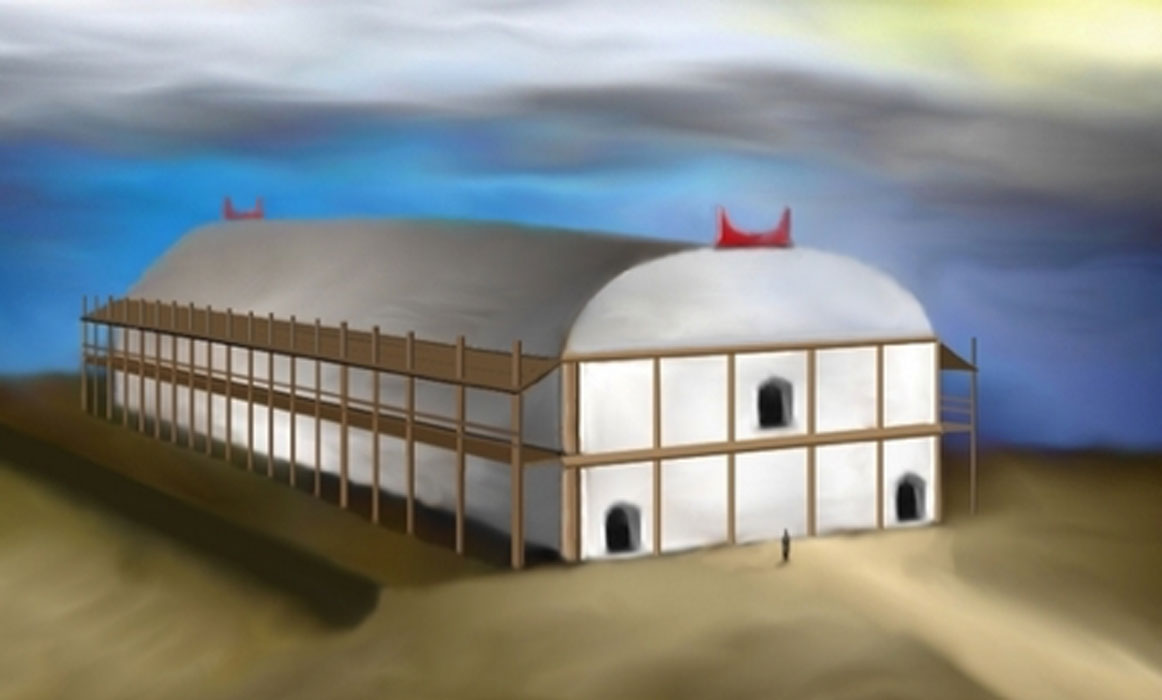Ancient Ukrainian Megastructures Were Huge Community Centers
Archaeologists have derived volumes of new data from a series of ancient megastructures found in a giant prehistoric Ukrainian settlements.
Maidanetske is a village located within the Talne Raion (district) of the Cherkasy Oblast (province), about 235 kilometers (146 miles) driving distance south of Kiev. Having emanated from modern-day Moldova and Romania about 4100 years ago, the Cucuteni-Trypillia culture began establishing large settlements housing up to 10,000 inhabitants and ranging across hundreds of hectares into modern day Ukraine.

Structures found at Maidanetske. (Hofmann et al.)
Renowned for their finely crafted pottery, the expansion of these huge settlements stopped around 3600-years-ago and many have remained unexplored. In a new paper published on PLOS ONE, lead author Robert Hofmann from Kiel University, Germany, and his colleagues, explain that “high-resolution magnetometry surveys” revealed that alongside houses measuring about 15 meters (49.21 ft.) long and 7 meters (22.97 ft.) wide, “megastructures” measuring up to 65 meters (213.26 ft.) long and 10 meters (32.81 ft.) wide were also discovered.
- Ancient Trap Ideas to Protect Your Tomb or Catch Your Lunch
- Eternal Flames: Geologists Investigate Ancient Myths to Know More about Modern Fuel
- The Odessa Catacombs: Lost in Eternal Darkness
Aiming to establish precisely what these vast spaces were used, for the team compared their megastructures to the measurements and dimensions of more than 100 similar megastructures from 19 ancient European settlements. But before we look further at the findings, let us first explore the origins of this far spread and deeply ancient culture.
They Grew From the Land
In a 2014 paper published on the European Journal of Archaeology, the roots of Cucuteni–Trypillia culture are traced to the Starčevo–Körös–Criș and Vinča cultures of the 6th to 5th millennia, with influence from the Bug–Dniester culture which existed between 6500 and 5000 BC. Over the course of the fifth millennium, the Cucuteni–Trypillia culture expanded from the Prut–Siret region eastwards along the Carpathian Mountains into the Southern Bug rivers of central Ukraine.

Representation of bull horns and a cross in Cucuteni culture pottery. Piatra Neamt Museum. (CristianChirita/CC BY SA 3.0)
Most settlements were located close to rivers, with the earliest dwellings being pit houses and then above-ground clay houses with clay floors and hearths were covered with roofing crafted from thatched straw and reeds.
An entry in the Encyclopedia of Ukraine informs that the major economic activities of the early Trypilians were primitive agriculture and animal husbandry, supplemented by extensive hunting, fishing, and food gathering. Land was tilled and sown with wheat, millet, and barley and these crops were harvested using bone sickles with flint blades, with the grains being ground by stone querns.
What Were the Ukrainian Megastructures Used For?
In the new study, Hofmann and his colleagues determined that the megastructures were mostly made from clay-covered split wood and log timbers, but perhaps more important than what they are, is where they are. They are always found at important locations within the settlement plans and while houses formed concentric rings, some of the megastructures were in open spaces built within the ring corridor, on paths, or on the outskirts of the settlements.

This aerial view shows the large settlement area of the Tripolye megasite Maidanetske with excavation areas. (CRC 1266)
So far as what they were used for, Hofmann and his team think the megastructures might have been community centers for religion, economy, and political decision-making; but the structures changed into public spaces over time. And article in New Scientist says that around 4100 BC smaller megastructures featured in the settlements serving various section of the communities.
Then, by 3600 BC, the smaller and medium-sized structures began to decline, leaving the largest of the megastructures - suggesting a strong centralization of the social and political decision-making processes, says Hofmann. And he suggests that if the centralization had been dysfunctional or because the population didn’t accept that model of society, this might provide a reason for ‘why’ the cities collapsed.

Reconstruction of the Trypillian city Maydanets c 4000 BC. (Kenny Arne Lang Antonsen/CC BY SA 4.0)
Ancient Mega Drought
While it is generally agreed how the Cucuteni–Trypillia lived, there is debate among scholars regarding how the culture came to an end. Before this new paper, according to proponents of the Kurgan hypothesis of the origin of Proto-Indo-Europeans, the Cucuteni–Trypillia culture was destroyed by the Kurgan culture, of the Pontic–Caspian steppe, in a series of invasions undertaken during their expansion to the west.
Their decline has more recently been associated with events beginning around 3200 BC when the earth's climate became colder and drier than it had been since the end of the last Ice Age. In this theory the worst drought in the history of Europe since the beginning of agriculture presented itself to the farming Cucuteni–Trypillia culture, which would have collapsed.
- The Cucuteni-Trypillian culture and the mysterious burning of the buildings
- Archaeologists unearth 6,000-Year-Old Temple in Ukraine
- Mauritius Square, Ukraine: What is this Giant Crab-like Earthworks?
According to The American Geographical Union, the transition to today's arid climate was not gradual, but occurred in two specific episodes. Firstly, between 6,700 and 5,500 years ago and then a brutal change lasted from 4,000 to 3,600 years ago when summer temperatures increased sharply and precipitation decreased.
It is thought that the neighboring Yamnaya culture who were pastoralists better survived the drought, leading some scholars to conclude that the Cucuteni–Trypillia culture ended not violently, but as a matter of survival, converting their economy from agriculture to pastoralism and becoming integrated into the Yamnaya culture.

Man from Yamnaya culture, sculptural reconstruction (c. 1930s). (Public Domain)
Top Image: Reconstruction of the Temple from Nebelivka, Ukraine. c 4000 BC Trypillian (Danube) civilization. 60x20m size. Based on information from "Temple on Nebelivka mega-site: reconstruction" by Nataliia Burdo, Mykhailo Videiko, Institute of Archaeology NAS of Ukraine, Kyiv. Source: Kenny Arne Lang Antonsen/CC BY SA 4.0
By Ashley Cowie

















